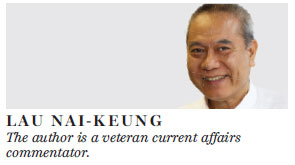People in the SAR should beware of frontier myths
Updated: 2015-09-30 09:48
By Lau Nai-Keung(HK Edition)
|
|||||||||
During the Han Dynasty (206 BC-220 AD), Middle and Central Asia was ruled by the nomadic tribe Xiongnu, or the Huns, whose ruling Luandi clan's supreme leaders were referred to as "Chanyu" (before the title was superseded by "Khagan" in 402 AD).
In 33 BC, the then Chanyu Huhanye visited Han's capital Chang'an as part of the tributary system that existed between the Han and Xiongnu governments. He took the opportunity to request, for the third time, to become an imperial son-in-law. Unwilling to honor Huhanye with a real princess, Emperor Yuan presented palace lady-in-waiting Wang Zhaojun as his own daughter and Huhanye married her.
There are quite a number of famous and colorful legends associated with Wang Zhaojun. Some say she was a fairy of Heaven. According to one legend, when Wang got out of the frontier pass and arrived at the Heihe, or Black River, the north wind blew so fiercely that neither people nor horses could move forward. At that moment, Wang started to play the lute or pipa, the gale stopped roaring and everything on Earth came back to life.
What matters here, for the purpose of our discussion, is the concept of the frontier. The frontier is where civilization ends and barbarianism begins.
The Americans also have their frontiers, and their frontiers symbolize colonialism and aggression. The American frontier comprises the geography, history, folklore, and cultural expression of life in the forward wave of American westward expansion that began with English colonial settlements in the early 17th century and ended with the admission of the last mainland territories as states in 1912. As neutral as it may sound, there was a lot of Native American blood behind the term "westward expansion". The natives did not know of any "frontier" - the concept was imposed on them.
While the US frontier at home ended in 1912, it still has other frontiers, notably in the Middle East, where it is still trying to impose its concept of civilization and order.
When China reformed and opened up, it designated Shenzhen as a special economic zone (SEZ) to experiment with reforms. While reform was a great thing, it also confused people's minds.
If, instead of to the Xiongnu, Wang Zhaojun were sent to the Shenzhen SEZ, she would be confused because the concept of the frontier is reversed. Shenzhen also has a frontier, where the side bordering Hong Kong is referred to as inside the frontier, or guannei; while the side bordering the rest of China is referred to as outside the frontier, or guanwai.
The terms guannei and guanwai have great semiotic significance. This symbolizes a Hong Kong-centric mentality, which is one of the causes of today's nativist movement in Hong Kong.
In June, Shenzhen's government announced that it is planning to dismantle the 16 checkpoints that originally separated the Shenzhen SEZ from the rest of the mainland. Relics of the 84.6-kilometer Shenzhen frontier, the checkpoints are a holdover from when residents and cargo were subject to inspection before entering Shenzhen from the rest of the mainland.
Although the checkpoints have not been used for years, the notion of a Shenzhen frontier is still very much alive. Today, green taxis are still required to operate "outside" the frontier while red taxis operate "inside". Shenzhen also learned this from Hong Kong.
Boundaries, borders and frontiers will always exist, officially or otherwise. In normal times, wealth, prestige and confidence reside inside the frontier. After the Opium Wars, this order was temporarily disrupted - what was outside the frontier had come to be considered more civilized and superior. Might was right. In a moment of insecurity and confusion, many sought refuge outside the frontier.
Chen Zuo'er, a former deputy director of the Hong Kong and Macao Affairs Office of the State Council and chairman of the Chinese Association of Hong Kong and Macao Studies, has lamented that decolonization in accordance with the law was not implemented in the city. This is so true.
First things first, let us help our modern Wang Zhaojun find her way back home. Luohu and Futian, for example, are now on the inside of the Shenzhen frontier, not outside. We are the ones waiting to be absorbed into the Chinese mainstream. If we get this right, then we are one step closer to decolonization.

(HK Edition 09/30/2015 page10)